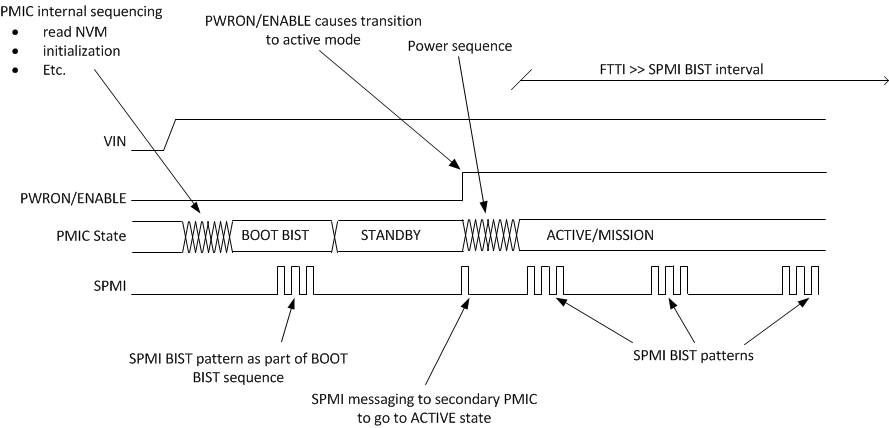SNVSAZ9 March 2022 LP8764-Q1
PRODUCTION DATA
- 1 Features
- 2 Applications
- 3 Description
- 4 Revision History
- 5 Pin Configuration and Functions
-
6 Specifications
- 6.1 Absolute Maximum Ratings
- 6.2 ESD Ratings
- 6.3 Recommended Operating Conditions
- 6.4 Thermal Information
- 6.5 Internal Low Drop-Out Regulators (LDOVINT)
- 6.6 BUCK1, BUCK2, BUCK3, and BUCK4 Regulators
- 6.7 Reference Generator (REFOUT)
- 6.8 Monitoring Functions
- 6.9 Clocks, Oscillators, and DPLL
- 6.10 Thermal Monitoring and Shutdown
- 6.11 System Control Thresholds
- 6.12 Current Consumption
- 6.13 Digital Input Signal Parameters
- 6.14 Digital Output Signal Parameters
- 6.15 I/O Pullup and Pulldown Resistance
- 6.16 I2C Interface
- 6.17 Serial Peripheral Interface (SPI)
- 7 Typical Characteristics
-
8 Detailed Description
- 8.1 Overview
- 8.2 Functional Block Diagram
- 8.3 Input Voltage Monitor
- 8.4
Device State Machine
- 8.4.1 Fixed Device Power FSM
- 8.4.2
Pre-Configurable Mission States
- 8.4.2.1
PFSM Commands
- 8.4.2.1.1 REG_WRITE_IMM Command
- 8.4.2.1.2 REG_WRITE_MASK_IMM Command
- 8.4.2.1.3 REG_WRITE_MASK_PAGE0_IMM Command
- 8.4.2.1.4 REG_WRITE_BIT_PAGE0_IMM Command
- 8.4.2.1.5 REG_WRITE_WIN_PAGE0_IMM Command
- 8.4.2.1.6 REG_WRITE_VOUT_IMM Command
- 8.4.2.1.7 REG_WRITE_VCTRL_IMM Command
- 8.4.2.1.8 REG_WRITE_MASK_SREG Command
- 8.4.2.1.9 SREG_READ_REG Command
- 8.4.2.1.10 SREG_WRITE_IMM Command
- 8.4.2.1.11 WAIT Command
- 8.4.2.1.12 DELAY_IMM Command
- 8.4.2.1.13 DELAY_SREG Command
- 8.4.2.1.14 TRIG_SET Command
- 8.4.2.1.15 TRIG_MASK Command
- 8.4.2.1.16 END Command
- 8.4.2.2 Configuration Memory Organization and Sequence Execution
- 8.4.2.3 Mission State Configuration
- 8.4.2.4 Pre-Configured Hardware Transitions
- 8.4.2.1
PFSM Commands
- 8.4.3 Error Handling Operations
- 8.4.4 Device Start-up Timing
- 8.4.5 Power Sequences
- 8.4.6 First Supply Detection
- 8.5 Power Resources
- 8.6 Residual Voltage Checking
- 8.7 Output Voltage Monitor and PGOOD Generation
- 8.8 General-Purpose I/Os (GPIO Pins)
- 8.9 Thermal Monitoring
- 8.10 Interrupts
- 8.11 Control Interfaces
- 8.12 Multi-PMIC Synchronization
- 8.13 NVM Configurable Registers
- 8.14
Watchdog (WD)
- 8.14.1 Watchdog Fail Counter and Status
- 8.14.2 Watchdog Start-Up and Configuration
- 8.14.3 MCU to Watchdog Synchronization
- 8.14.4 Watchdog Disable Function
- 8.14.5 Watchdog Sequence
- 8.14.6 Watchdog Trigger Mode
- 8.14.7 WatchDog Flow Chart and Timing Diagrams in Trigger Mode
- 121
- 8.14.8 Watchdog Question-Answer Mode
- 8.15 Error Signal Monitor (ESM)
- 8.16 Register Map
- 9 Application and Implementation
- 10Power Supply Recommendations
- 11Layout
- 12Device and Documentation Support
- 13Mechanical, Packaging, and Orderable Information
Package Options
Mechanical Data (Package|Pins)
- RQK|32
Thermal pad, mechanical data (Package|Pins)
Orderable Information
8.12.4 SPMI-BIST Overview
The SPMI-BIST is performed during BIST state and regularly during runtime operation. Figure 8-40 below illustrates how the SPMI-BIST operates during device power-up.
 Figure 8-40 SPMI-BIST
Operation
Figure 8-40 SPMI-BIST
OperationAfter the input power is detected and verified to be at the correct level, the LP8764-Q1 initializes itself by reading the NVM and performs all actions that are needed to prepare for operation . After this initialization, the LP8764-Q1 enters the BOOT BIST state, in which the internal logic performs a series of tests to verify that the LP8764-Q1 device is OK. As part of this test, the SPMI- BIST is performed. After it is completed successfully, the LP8764-Q1 device goes to the standby state and waits for further signals from the system to initiate the power-up sequence of the processor.
A valid on request initiates the processor power-up sequence. The controller device communicates this event through the SPMI bus to all of the target devices. After that, the power-up sequence is executed and LP8764-Q1 enters the configured mission state.